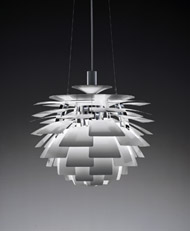Design Classics
Artichoke Hanging Lamp, 1958
Designer: Poul Henningsen
Manufacturer: Louis Poulsen

Poul Henningsen (1894–1967) was a multi-talented Danish architect, writer, poet, filmmaker, inventor and left-leaning social critic. He trained at the Copenhagen technical school, but fled to Sweden during the Second World War. A champion of socially and politically progressive ideas, he advocated a utilitarian approach that would bring good design to “the masses” through improved work and domestic environments. In Denmark, Henningsen was so famous as a cultural hero he was simply called PH.
WHAT
Having grown up in a small Danish town before electric lighting was common, Henningsen was dismayed at the dismal, harsh quality most electric light fixtures gave to interiors. The series of lights he began working on in the 1920s were his answer to what he called his search for “harmony in lighting.” Rather than respond to “the ever-increasing demand for more powerful lighting intensity,” he sought to tame the harshness of artificial light. In this quest, glare was the primary challenge.
Henningsen's 1924 multi-shade “PH-lamp” uses a series of three overlapping metal shades to hide the source of light and then deflect, diffuse and distribute it. The lamp won an award at the 1925 Paris Exposition des Arts Décoratifs et Industriels Modernes and became known as the “Paris” lamp.
After the resounding success of the original PH lamp (they were used at the Bauhaus school), Henningsen continued to develop his ideas about lighting. In 1958, he was commissioned to design the interior of a Copenhagen restaurant called the Langelinie Pavilion. His challenge was to light the interior and create a festive atmosphere while still providing the amount of light required for a large public interior. The Artichoke lamp – named for its obvious reference to an upside-down vegetable – expanded to 12 the layers that diffuse light. The sheets were originally made of brushed, lacquered copper on the outside and pink on the underside, which added a subtle tonal quality to the diffused light. While the giant, original-size Artichoke is ideal for grand spaces, Henningsen also developed a scaled-down version for residential use.
WHY
The Artichoke lamp is a spectacular solution to the glare and harshness inherent in artificial light. Henningsen solved these problems with multi-layered shades that hide the bulb while softening and colouring the light. But the Artichoke lamp is not just a scientific solution; it is also exuberant and humane. But the price (over $7,000) might cause you to … ahem … choke.
National Post, May 25, 2006.
